...with a big portion of delicious creativity and topped with adorableliciousness!
Don't wanna be here? Send us removal request.
Photo


767 notes
·
View notes
Photo









shit Jae-ha says (or mostly him just fucking with Hak)
2K notes
·
View notes
Photo

The Daily Word Counts of 39 Famous Authors
17 Of The Most Powerful Excerpts From Poetry
37 Ways To Write About Anger
Six Sub-Plots That Add Style To Your Story
93 Extremely Bad Business Writing Habits to Break
Torture your Character - The Three Most Effective Types of Inner Conflict
Proust’s Questionnaire - 35 Questions Every Character Should Answer
How To Become A Writer - The Easy Way - by Neil Gaiman
When To Use ‘That’ And When To Use ‘Which’
How To Write A Beginning And An Ending That Readers Will Never Forget
11 Things To Know About Dating A Writer
Word Counts - How long should your novel be?
Howdy Ma’am: Three Ways To Introduce Your Characters In The First Few Lines
10 Things To Stop Doing To Yourself As A Writer
The Five Best Online Tools to Help You Outline Your Novel
Make Me Care - Nine Ways To Ensure An Unforgettable Read
The Three Mistakes Writers Make That Stop Us Reading Their Books
Why First Time Authors Don’t Write The Books They Want To Read
How To Avoid ‘Telling’ Words
The Opposite Habits of Famous Writers
The Nine Types of Unreliable Narrator
13 Ways To Start A Story
The Three Surprises You Need In A Story
Six Questions To Ask Before You Even Start Your First Draft
The 12 Worst Mistakes People Make In Email Subject Lines
NaNoWriMo Calendar – Organise and Conquer!
Literary Style: 15 Writers and Their Bedrooms
The Romantic Sub-Plot - Six Uncommon Romantic Love Interests
Three Steps To Help You Write Brilliant Descriptions
10 Remedies For The Horrible Things Writers Tell Themselves
180 Emotionally Powerful Words To Use In Headlines
Write Small - Five Ways To Make Your Reader Care
How To Plot A Perfect Scene In 10 Minutes
It’s Never Too Late To Start Writing - When 27 Famous Authors Were Published
One Goal To Rule Them All – Five Things To Consider Before You Write An Epic Fantasy
Unhinged — Three Plot Devices You Should Definitely Be Using
12 Inspiring Literacy Quotes
10 Elementary Tips For Writers From Sherlock Holmes
Four ways to remove padding words
Five Ways To Create Fictional Conflict That Counts
The Writer’s Journey - Five exercises to get you started
Three Lines That Will Help You Write A Better First Draft
2K notes
·
View notes
Photo






“Your being here, and smiling… I couldn’t ask for anymore than that.”
↳ requested by @y-u-k-i-n-a
371 notes
·
View notes
Text
Writing Tip July 16th
We’ve wrapped up the grammar portion of the month, which means we are moving on to the fight scene portion of the month. We will cover tips on how to write the actual fight, as well as information on injuries and the like. Without further ado:
5 Essential Tips for Writing Killer Fight Scenes
Fight scenes are dangerous territory for writers. On the surface, they seem as if they’re guaranteed to keep the reader glued to the action in the same way as they often do at the movies. In reality, though, readers tend to skip over fight scenes – skimming the long, tedious, blow-by-blow descriptions in favour of getting back to the dialogue and character-driven drama that truly engages them in the story.
My novel, Traitor’s Blade, is a swashbuckling fantasy in which fight scenes are a crucial part of the storytelling. This means having to ensure that every piece of action is vital and engaging; it means that every duel must draw the reader in and not let them go until the end. So how do you keep the pacing, flow, and more importantly, the drama moving forward with so many fights?
1. Make every fight advance the plot
No matter what you might think, violence is actually boring. Watching two hulking brutes bash at each other with clubs isn’t interesting. Only when one of the brutes is smaller, weaker, and trying desperately to stay alive long enough to let his people know that the enemy is coming does the action start to matter to the reader. But don’t just think in terms of climactic battles or killing off enemies. Sometimes the fight provides a crucial piece of information about the antagonist such as a particular type of cut they make that could explain the wounds on a victim the protagonist discovered in the previous chapter. The fight might also wound your protagonist, slowing them down in later scenes and giving you a chance to make their lives harder and therefore increase the suspense.
2. Reveal character through action
The way your protagonist fights – and when they choose to fight or walk away – tells the reader a great deal about them. Your hero might be a skilled but retiscient warrior or they could be an amateur but with a bloodthirsty streak that comes out when confronted with violence. But don’t just stop with your protagonist or their opponents. Think about what the action reveals in those watching the fight. Does the seemingly helpful mentor figure suddenly become enraptured watching the blood flow? Do the innocent bystanders just sit there or do they scramble to help? Fight scenes that reveal character are by far the most compelling ones for readers – they get to investigate your characters by seeing how they deal with violent situations, allowing you to follow that classic dictum of modern writing: show, don’t tell.
3. Your fight scenes must fulfill the promise of your book
Traitor’s Blade is a swashbuckling fantasy so every fight has to give the reader some of that sense of wonder they first encountered watching classic adventures like the old Errol Flynn and Douglas Fairbanks films. But perhaps your genre is gritty historical fiction. If so, the last thing you want to do is break suspension of disbelief. You have to carefully ensure that the weapons and fighting styles are true to your era (note: this doesn’t mean you can’t have a longsword in the 18th Century since they were around for long periods of time after their proper era, but you can’t have King Arthur swinging a rapier around in 6th Century Britain!)
4. Make every fight unique
I read a YA fantasy recently in which almost every fight involved the main character jumping up and spinning in the air to kick opponents in the face (usually two or three.) Regardless of how unrealistic this would be (after all, realism only matters if it’s part of the promise of your book), the fact is you probably couldn’t remember one fight from another. By contrast, think of a movie like The Princess Bride, in which every fight is special – every conflict is resolved using different means, whether trickery or skill or simply iron-willed determination.
5. Let the reader choreograph the action
If you describe every action of the fight, not only will you bore the reader but your pacing and flow will fall apart. So think of your job not so much as having to meticulously choreograph the fight but rather to give the reader enough insight into the action that they can build the scene in their minds. Show them early on in the fight how each weapon moves through space—make that vivid and visceral. Make the reader feel as if they could actually pick up that weapon and defend themselves even just a little bit. Then you’re free to focus on the character’s actions and reactions—making them distinct, personal, and emotionally motivated just as you do with their words. The reader will then be able to fill in the action while you describe what your characters are saying, what they’re thinking, and what’s showing on their faces. In other words, help the reader to choreograph the fight so that you can spend your time on the drama. This also lets you vary the length of your fight scenes, which helps to keep them from becoming predictable. In Traitor’s Blade there are fights which span an entire chapter and others which are told in four lines.
Think of it this way: violence is dialogue. Make your fights into a conversation spoken with actions in which the real conflict is happening in the hearts of the characters and in which the reader themselves are helping to tell the story.
-Chuck Sambuchino
115 notes
·
View notes
Photo

Haku and Yona with Son (✿ ♥‿♥)
(My Favorite Haku x Yona fan art forever and ever!!)
Wonderful Fan Art By:K_Ponbon please do not remove source/credit || Permission ❀
3K notes
·
View notes
Text
okay but why no one talks about this??



“IT STIRS MY DESIRE” (//ω//)
226 notes
·
View notes
Photo










Thunder Beast Hak
“When you protect someone you want to keep safe, do you always weigh your own life against theirs?”
515 notes
·
View notes
Text
Soundtrack for writers
Writing without music kind of gets me stuck. I don’t know what happens, I feel incomplete. The wrong type of music, however, throws me off. If, just like me, music is an important part of your writing process, this is the post for you.
Sound effects websites:
Rainy Mood
Shower Time
Coffitivity
Soundrown
Noisli
Rainy Cafe
A Soft Murmur
Snowy Mood
Sound effects on YT:
- Journey
Night train
Night train with rain
Car ride
Car ride with rain
Airplane cabin
Pirate ship
Pirate ship with rain
Spaceship
- Nature
Garden
Swamp
Rainforest
Snow storm
Snow storm with fireplace
Winter wind
Winter waterfall
Beach
River
Desert with wind
Field
Underwater
Haunting storm
Cave water
- Places and events
Airport
Restaurant
City
Train station
Shopping mall
School
Convention center
Call center office
Fireworks
Classical music:
Liszt
Handel
Villa-Lobos
Mahler
Mussorgsky
Paganini
Clara Schumann
Robert Schumann
Haydn
G.P. da Palestrina
Rossini
Verdi
Chopin
Takemitsu
Salieri
Elgar
Debussy
Gershwin
Satie
Soundtracks:
Ghibli
Lord of the Rings
Skyrim
Pirates of the Caribbean
Harry Potter
Naruto and Naruto (villains)
Journey
Disney
Star Wars
The Terminator
The Last of Us
Cowboy Bebop
The Ring
Edward Scissorhands
Sleepy hollow
The Village
Until Dawn
Layers of Fear
Outlander
Downton Abbey
This War of Mine
Hunter x Hunter
Pride and Prejudice
Clannad
Marco Polo
House of the Flying Daggers
Baccano!
Somewhere in time
The Order
The Notebook
Final Fantasy X
Final Fantasy XIII
Van Helsing
Anno 1404
Jurassic Park
Lost
Titanic
The Last of the Mohicans
One Piece
9K notes
·
View notes
Link
One of the basics steps when writing a story is research. Looking for an specific topic is easy, but sometimes you forget that elements are connected and when you start writing about them you realise you have to make more research and have to stop writing just when…
1K notes
·
View notes
Link
To sell your novel, you may need to know how to write a synopsis, even if you are a pantser-type novelist who can write a whole novel without making an outline first. Agents and publishers will often ask for a synopsis along with sample chapters before they request a complete manuscript.
The biggest mistake most people make when they try to write a synopsis for the first time is to create a bare bones plot summary, along the lines of “First this happens, then this happens, then this happens…” Synopses written this way tend to be so dry and boring even the author would have trouble understanding why anyone would want to read the full novel.
Imagine, for example, if a sports writer described a hockey game as “First one team scored. Then the other team scored. Then the first team scored twice. Then the game ended.” Pretty boring, yes?
- See more at: http://www.how-to-write-a-book-now.com/how-to-write-a-synopsis.html#sthash.luoazyx1.dpuf
Read More →
565 notes
·
View notes
Quote
I don’t know what I think until I write it down.
Joan Didion (via simplewritingtips)
132 notes
·
View notes
Link
There are a lot of choices to make when writing a novel. I know a lot of writers struggle with being decisive and often get hung up on making certain choices about their story. What should I name my book? What should I name my protagonist? Why should my character make this…
3K notes
·
View notes
Photo



“I’ll teach you some exercises as an apology.”
1K notes
·
View notes
Photo

(via Bridgid Gallagher - Plot your novel for NaNoWriMo)
27 notes
·
View notes
Photo
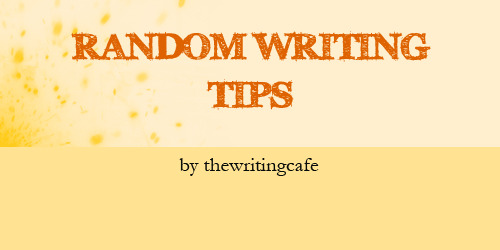
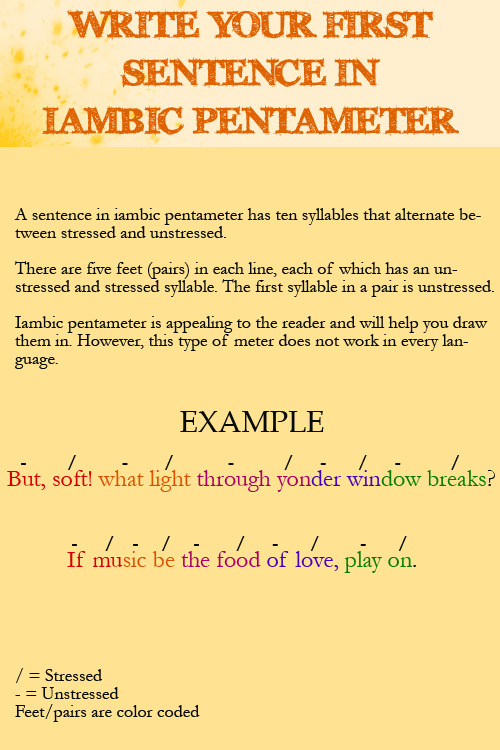
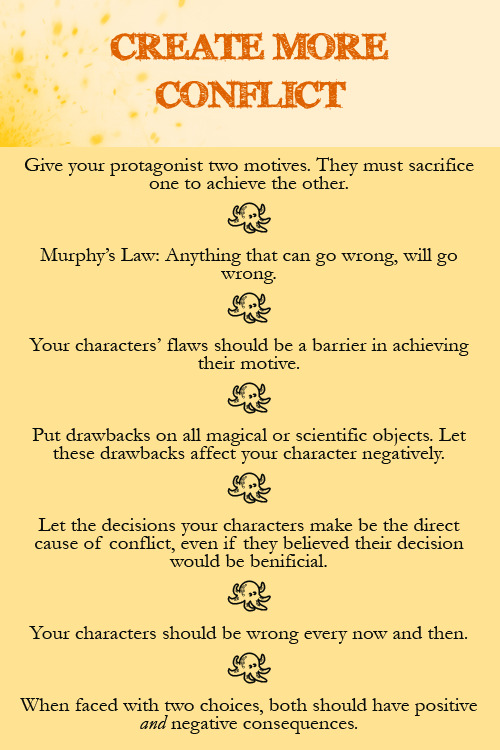
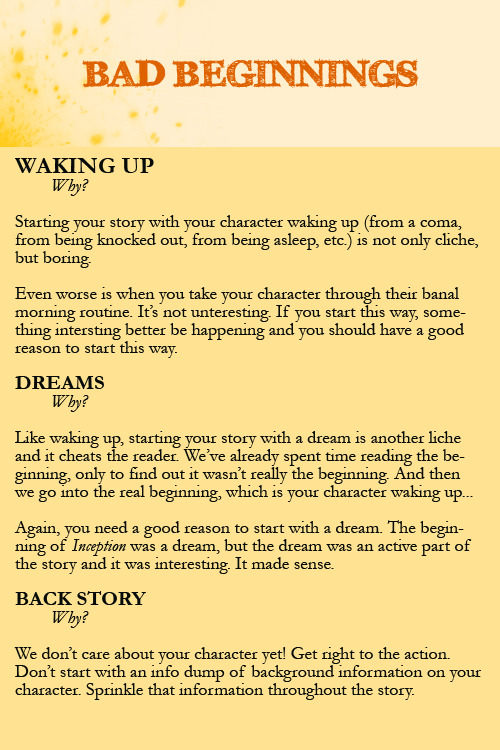
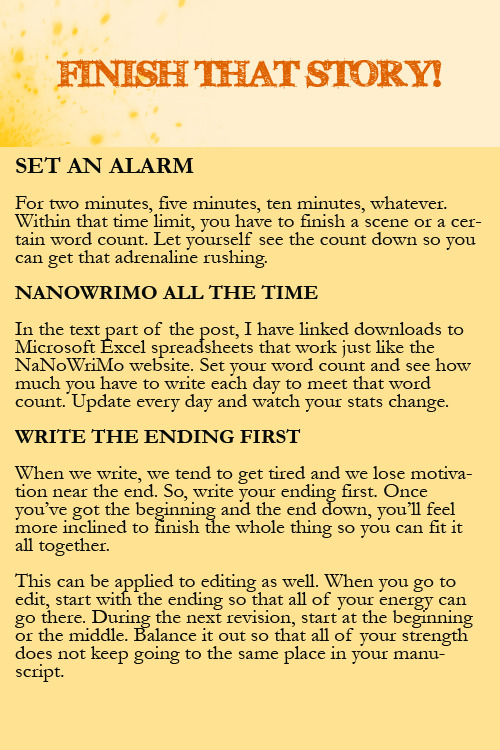
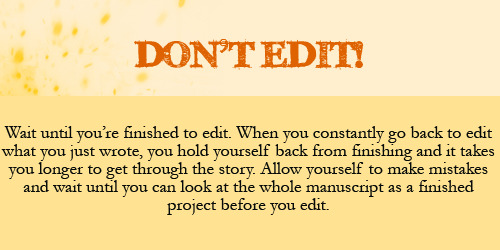
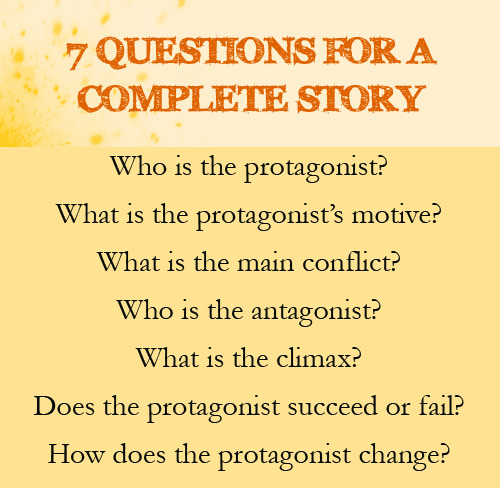
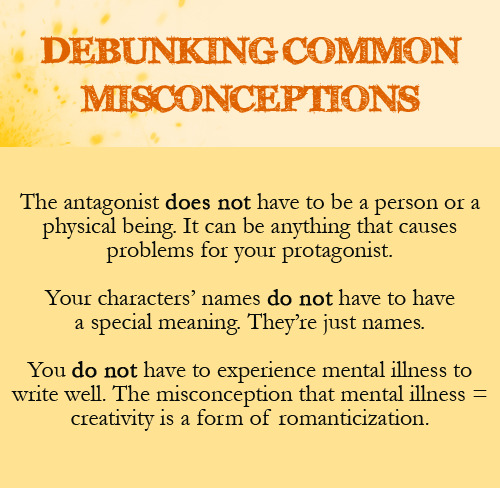
Word Tracking Spreadsheets - These sheets also have sections for character and plot information.
93K notes
·
View notes
